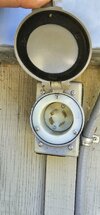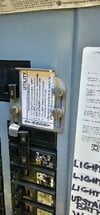So I just returned from a trip to Yosemite where I had rented a small cabin near the Supercharger at El Portal. Upon arriving to the cabin, I noticed an outdoor outlet cover. Upon inspection, it had a male L14-30 which I thought was odd. Asked the person at the front desk about charging and she said they are fine with charging the car there, but had no adapters that fit this connector. Upon closer inspection into the adjacent breaker panel, the only 30A breaker had a lockout that requires one to turn off the main breaker. I figured out it was for connecting a generator and the male L14-30 suddenly made sense.
Made me think though, what if one were to assemble an adapter cable with a female L14-30 to 14-30 outlet and simply remove the lockout temporarily. I'm not sure this facility would allow this, but I thought this may make for a bit of an interesting thought exercise for creative ways to charge. I don't see any technical issues other than making sure you don't exceed the load of the box. This one was 100A box and the cabin was attached directly to the office so who knows what they have running in there; the cabin had an in-wall AC unit and I'm sure they're was some kind of AC running in the office. None of the other breakers were more than 20A. Though, the office is open only from 1PM to 9PM so it's possible one could get 24A after hours.
I'm not sure if the detached cabins at this property have such a connector as this may have been installed to run the office if power goes out.
Attached photos of the connector and lockout. Also added one of Yosemite Valley just because.
Made me think though, what if one were to assemble an adapter cable with a female L14-30 to 14-30 outlet and simply remove the lockout temporarily. I'm not sure this facility would allow this, but I thought this may make for a bit of an interesting thought exercise for creative ways to charge. I don't see any technical issues other than making sure you don't exceed the load of the box. This one was 100A box and the cabin was attached directly to the office so who knows what they have running in there; the cabin had an in-wall AC unit and I'm sure they're was some kind of AC running in the office. None of the other breakers were more than 20A. Though, the office is open only from 1PM to 9PM so it's possible one could get 24A after hours.
I'm not sure if the detached cabins at this property have such a connector as this may have been installed to run the office if power goes out.
Attached photos of the connector and lockout. Also added one of Yosemite Valley just because.





